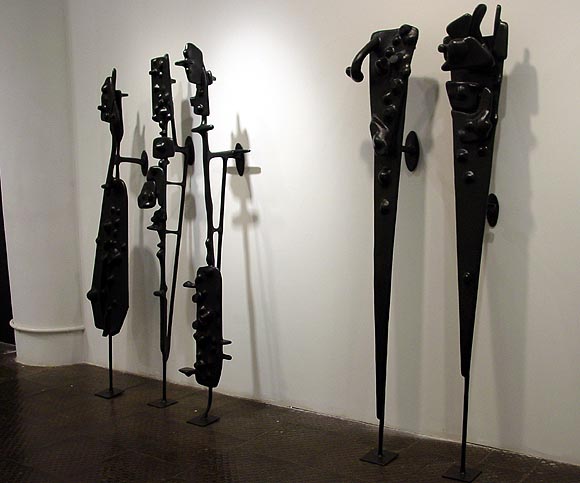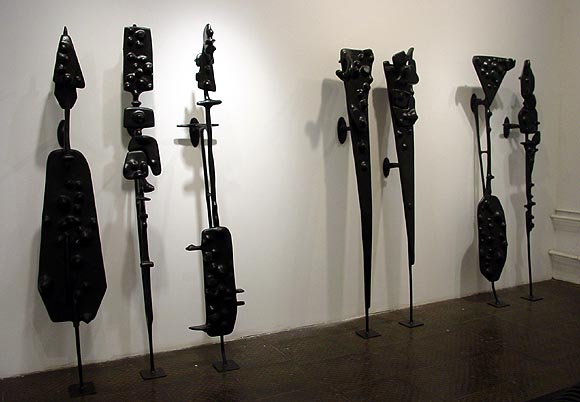View current page
...more recent posts

This bit of unabashed, 40 years after the fact Pop Art is the best piece in Damien Hirst's painting show at Gagosian. The quality level/vibe of the rest of it is much like the canvases Ludwig Schwarz (and also an artist in Germany who's name I'm blanking on) did where they hired a company in China that will render any photo as a photorealistic oil. Hirst's contracted-out art is actually slightly more inept, hand-wise, than those guys'. The photos chosen were his typical death from life, life from death themes. He's having us on as usual, but also heading down the painting-on-canvas trail that many conceptualists follow to stay market-viable. Usually that's when they--sorry for the pun in Hirst's case--"jump the shark." (But of course Hirst has been producing paintings all along, clever bastard: the dots, which are kind of good, and the Walter Robinson-derivative spin paintings.) As joester points out on Sally McKay's page, the Gagosian set
...weren't painterly paintings. They had wiener symptoms (where every brush stroke looks like a wiener) and were really ugly to look at up close. Not ugly in a good way, ugly in a rushed "oh my god I have to paint 12 of these by wednesday" way.That's really all you need to know about the show. The work is too lame to merit any discussion of crack addicts, bloodied football hooligans, dissected brains, appropriation theory, and whatever else they they've raised. The forced "downer" themes also recall Cindy Sherman's vomit photos, an extended lament over the curse of success without end that attaches itself to "canonical" visual artists, more than any other type of creator (because we still have this medieval idea that art is iconic and forever, reinforced by a market that needs a canon). "I know--I'll make something they'll really hate." Except they don't hate it.

Karen Kilimnik: So much better than Elizabeth Peyton it's not even funny
Here are some quotes from a silly New York Times article today about the disparity in auction prices between male and female artists (thanks again, Bill):
One more example. Since three emerging figurative painters - Luc Tuymans of Belgium and the Americans John Currin and Elizabeth Peyton - were exhibited together at the Museum of Modern Art in 1997, they, too, have come to seem almost like classmates, all heralded as leading figures in painting's contemporary resurgence. [What resurgence? Painting left the art market for about two years in the mid-70s, it hasn't gone away since.] The two men's canvases have sold for more than $1 million. Meanwhile, Ms. Peyton's 1996 oil portrait of a languorous John Lennon is estimated by Christie's at $200,000 to $300,000. And even that is a lot more than the current record price for her work: $136,000, set in June 2002.This is great news. Perhaps there is a (benign, de-gendered) God, after all. Peyton's work is tepid and blandly illustrational: rather than languorous the paintings would be better described as fey, or wan, and that's all she does, fey and wan, over and over and over. Stupid looking people all with the same cherry red lips--how about some other colors for those? Karen Kilimnik's good bad paintings ca. 1997 would have been a better choice for that particular (overrated) MOMA show.
Art defies head-on comparison. Forget apples and oranges; how does one judge the value of [Rachel] Whiteread's cast fiberglass and rubber mattress relative to Mr. Hirst's deteriorating shark? Or of Maurizio Cattelan's sculpture of a taxidermied ostrich compared with [Agnes] Martin's canvas with the faintest of graphite grids on it? The contemporary art market has at least one frustratingly simple answer: price. And from that perspective, the comparison is unmistakable: art made by women is regarded less highly than art made by men.This argument is tautological: the art world chooses men over women in the competition for higher prices; choices can't be easily made; the only criteria for choosing is price. Art doesn't actually "defy comparison," people do it all the time, and usually not as ludicrously as above. You compare artist to artist, rather than arbitrarily chosen artwork to arbitrarily chosen artwork.
In all of the following comparisons (originally posed in the article), the former artist is protean, energetic, and innovative and the latter is refined, narrow-ranged, building on and deepening existing ideas, and sorry, we tend to value one more than the other: Philip Guston vs Joan Mitchell, Damien Hirst vs Rachel Whiteread, and (if you must compare these two) Mauricio Catellan vs Agnes Martin. Guerrilla Girl repellent: "Women can make art as well as men can. Many of the artists mentioned in the article are undervalued and the market will eventually correct for that, but on the basis of scholarship and consensus, not nitwitty New York Times articles that refuse to make meaningful comparisons."

Lucas Samaras' Hands, animated GIF, 2005
Made it to the last night of Bent 2005, the circuit bending festival, at the Tank, located on a "soon-to-be-bulldozed part of far West 42nd Street," as the Washington Post describes it. Downstairs people were sitting at benches with soldering guns disassembling toys and appliances, rewiring them to make interesting electro-gnarly sounds; upstairs people were performing using such instruments. The Post article about the festival is here; an excerpt discussing a previous night's performances gives you the flavor:
None of these people is playing songs, in the sense that a song has a chorus and lyrics, a beginning, middle and end. For the most part, the performers just make noise for about 10 minutes, then the noise subsides and when they say "thank you," you know the song is over. The pleasure for performer and fan alike comes from the textures of the noise, the idea of it as a landscape that has never been experienced before. It's all about sonic novelty. You get the sense, too, that these circuit benders just like to freak people out. T-Bone, for example, wears braids, which give her the look of a schoolgirl, until you notice the top of her head, which is shaved and vividly tattooed, like a Technicolor yarmulke. One can only think of her parents.Note to the WaPo writer: Dude, you're obviously interested in this subject or you wouldn't have spent the time writing and researching it to the degree you did; you definitely took it beyond a "mere assignment." So why the condescending tone throughout your article? Is it to satisy your editors? Are you reaching out to some perceived middlebrow reading audience that you feel wouldn't like this music and that you have to apologize in advance to? Get a blog, you can be more honest. (And I can't believe you called Texas Instruments to ask the PR person if the company knew Speak and Spells were being bent. What a journo-nerd. And the performers don't generally say "Thank you," they just stop. )
Back to the festival. At 5:00 pm Paul B. Davis of BEIGE/8-Bit Construction Set gave a Nintendo-hacking workshop. In contrast to fellow BEIGE-r Cory Arcangel's lectures on this subject, which are generally laff riots, Davis's was calm and droll, but similarly informative and persuasive on the hacking principals underlying the dismantling of silly games from people's youths. He makes a distinction between general purpose computers (like the one you're reading this on) and special purpose ones (like a pocket calculator) and points out that the old game cartridges are the former, and thus can do the same kinds, or categories, of things a sleek laptop can do--it's just a matter of accessing and reprogramming them. Opening up a Nintendo cartridge and burning new data to it is a way to gain access to a device brimming with art and music making potential, albeit on the low res end of the spectrum. The age or nostalgic appeal of the machinery is interesting but largely irrelevant.
Davis came back around midnight and did a DJ set interspersed with surprisingly substantial ringtones played on his Ericsson phone through the Tank PA. Cellular audio has noticeably improved from the early bleepy stage--if improved is really the right word considering most of the material is still cheesy pop songs. The vinyl set featured electro, Grime (a successor to 2-step garage in the London club scene), and Funk Carioca, which is new to me but quite amazing. Here's a description I found googling:
Funk Carioca (Rio funk) is the product of Brazil's favelas parties and fuels the night-long bailes that form the nocturnal soundtrack of Rio's hills. Funk Carioca combines street smarts with popping dirty electro beats and the intensity of DIY techno topped with some crude lyrical rhymes resulting in an irresistible cocktail that grabs you by the hips and never lets go.More on the Bent Festival, including photos, possibly, soon.
Edited slightly for coherency, accuracy, tact, etc.
Our tax dollars at work: in case you didn't hear, Ahmad Chalabi has been named oil minister in Iraq's shaky, US-propped-up government. They say it's "interim"--yeah, right. This sleazy con man, the Administration's pet Iraqi exile during the Saddam years, provided much of the fake weapons of mass destruction "intel" that dragged us into war in his country. He is a fugitive from justice in Jordan after embezzling millions from a bank there, and has been accused of passing classified information to the Iranians. Iraqi ministers get to hand out patronage positions, so he'll soon be surrounding himself with cronies and hobknobbing with US oil companies, as he prepares to rob his countrymen blind of their biggest material asset. It's sickening the US has aided this creature in his climb to power, with tax money and the lives of so many soldiers.
Jack Masters responds on his blog to the following mildly sniping paragraph posted here a few days ago:
The castlezzt.net guy has a blog now. He's posting under the name "Jack Masters." Interesting pictures, funny/surreal descriptions of dreams, wry philosophical musings, including thoughts on Excel charts that make me suspect a connection to the IT industry (who else would care about Excel?). He's been updating castlezzt, too, and I guess it was inevitable given the cost of bandwidth that "the mile long web page" has been broken into multiple pages.Masters' reply, accompanied by this great Pokey the Penguin drawing (thanks, anonymous):
Sorry, man. I was doing some heavy interpolating (and projecting).
My bandwidth is fine, it's just that it was getting to be quite an ordeal to load the page.
Actually I have no connection to the IT industry at all, I just use excel to record ideas. It has certain advantages over a simple text file, because you can easily rearrange things, or even have the computer alphabetize or randomize them. My notes tend to take the form of lists anyway.
In the screenshot that accompanied the excel post, I was using it to map out the edge permutations of a blank jigsaw puzzle I was working on. I've also used it as a poor man's cellular automata, and various other things.

Top: Lucas Samaras. A couple dozen brand spankin' new Apple flat screen monitors are arrayed on tables inside PaceWildenstein, as in a classroom or library. From a central server one can call up hundreds of photo stills or Quicktime videos by the artist, documenting his strange solitary existence inside a luxury high rise garret in Manhattan. A handful of elementary Photoshop filters are employed to psychedelify mundane actions such as blowdrying his hair and beard, watching TV by himself on New Year's Eve, recording sunsets and Macy's Thanksgiving floats. Kind of poignant, all this, and occasionally stunning despite the familiarity of the effects. Below: Walter Redinger of London, Ontario, who shares Mitchell Algus' gallery with Banks Violette this month. The sculptures below are the artist's trademark fiberglas resin, suggesting Yves Tanguy by way of the Star Trek props department, or Max Ernst with a plague of boils--and I mean all that in a good way. Very strange, excellent sculptures. A bit more on Redinger here.


Eyebeam has organized a contest on the theme of contagious media, the idea being to come up with a meme (project, hoax, web page, joke) that gets you the most hits within a certain period of time. This occupies an awkward zone between social sculpture (art), public relations (not art), new media art, and web-development-as-usual. Participants in the workshops include Nick Denton of Gawker media, who didn't wait to see how the unruly and amorphous new form of expression called "blogging" would evolve but rather led the charge in turning it into something streamlined and branded a la the late 90s dot com model. Blogs under the Gawker umbrella are much like the one you're reading except they have nicer logos and blinking ads interspersed with the copy. They do get hits though. This page has had a couple of mentions on a site called Screenhead (thanks, mon) and both times stats spiked big time.
Speaking of stats, mine are great, thanks. Numbers aren't crowed about here like they frequently are at Josh Marshall's blog but let's just say they're very encouraging and I appreciate everyone who reads. One of the discussions I had early on with fellow bloggers at Digital Media Tree (a collective that is the brainchild of tech whiz Jim Bassett) is that blogging isn't like dot coms because it isn't about number of eyeballs but quality of eyeballs. "Paradigms (memes, whatever) grow around communities of strong interest" is another way of saying it. Well, maybe they do, maybe they don't--you never know what's going to be important in the long or short run. But a perverse thing about the Internet is too much success can destroy the effort before it begins: bandwidth costs money, and more traffic makes blogging more expensive. To accommodate the traffic you have to upgrade and put up ads or a tip jar to keep going.
It can be exhilirating to have a contagious project take off, but recent history teaches us the party's quickly over and you're left picking up your guests' cigarette butts. The only solutions to the problem of the hit meme are to embrace capitalism, quit while you're ahead, or be like the characters in Kurt Vonnegut's short story "Harrison Bergeron," who wear prosthetic devices that blunt their natural talents (thick eyeglasses for painters, heavy ankle weights for ballerinas) so they're perpetually good but not too good.
And when it's all said, what did "Turkish Man Kiss You" and "America We Stand As One" really contribute to the discourse? Is their "success" as ironic artifacts something that could, or should, be deliberately contrived?
Updated slightly to accommodate a good point from someone who seemed mildy surprised that these things get updated/rewritten after they're posted (let me know if you want credit for the thought in the last sentence). The rule of thumb is if the post changes substantively I do an "update," otherwise it's just sub-Orwellian tweaks.
